Nara Itinerary: An Easy Day Trip from Kyoto
The historic city of Nara makes for an easy, relaxing, and interesting addition to your Kyoto itinerary. It’s got a lot to see and do for history, culture, and food lovers: giant Buddhas, famous temples and shrines, friendly deer, and great food. Visiting the city is also a great way to escape from the hustle and bustle of the bigger and busier cities of Japan.
In this post, I’m going to share with you how to visit Nara as a day trip from Kyoto. You’ll find information on what to do in the city, where to eat, how to get there, and how to get around.
However, if you can fit more days for Nara into your Japan itinerary, then I highly recommend doing so. The city has so many UNESCO World Heritage Sites that to see them all requires three days.
Disclosure: This post may contain affiliate links. As an Amazon Associate and a Bookshop.org Associate, I earn from qualifying purchases. Please see this website's Disclosure for more info.
In This Nara Post, You’ll Find…
Click on any item below to jump to that location in this article.
Why visit Nara
There are five main reasons to do some Nara sightseeing.
1. UNESCO Heritage Sites
The first reason to make a trip to Nara is that it has 8 UNESCO World Heritage Sites:
- Todaiji Temple– Day 1
- Kofukuji Temple – Day 1
- Kasuga-Taisha Shrine – Day 1
- Gangoji Temple – Day 3
- Toshodaiji Temple – Day 2
- Yakushiji Temple – Day 2
- Heijo Palace – Day 3
- Kasugayama Primeval Forest – Day 3
2. History
The second reason to make a day trip to Nara is for its history. It was the first permanent capital of Japan from 710 to 784.
Before Nara, Japan used to move its capital every time an emperor died (Lonely Planet, 2022). However, during the Nara years when Buddhism became popular, this belief died out.
Why was Nara the capital for only 74 years?
There is no clear answer. It could have been because the court wanted to limit the power of the Buddhist monks who had become too powerful during the Nara period. Two other possible reasons may have been economic or logistics. Nara has no rivers, but Kyoto does.
3. Buddhism
Another reason Nara is an important destination is that it played a central role in the initial rise of Buddhism in Japan.
Buddhism began to spread throughout Japan when Nara was its capital. At that time, the Emperor and many powerful families donated a lot of money to Buddhist temples and monasteries. Many of Japan’s most important Buddhist temples were built including the world’s largest wooden structure in the world, Todaiji Temple, and the most important Buddhist temple in Japan, Horyu-ji Temple,
4. Art
The fourth reason to add Nara to your Japan itinerary is that Nara has some of the best Buddhist works of art in Japan.
The Nara period occurred during the height of Chinese civilization. Japan wanted to emulate China. Emperors sent emissaries to China to learn government, art, and Buddhism from them, and the Chinese sent teachers and monks to Japan.
Japan imported not only ideas but also medicine, musical instruments, furniture, paper, and many more. The Nara National Museum houses these objects.
The National Treasure Museum at Kofukuji Temple and Sangatsu Hall have some terrific Buddhist works of art to view.
5. Friendly Deer
For the non-historian, Nara gives the visitor a great experience in feeding wild but incredibly friendly deer. You can buy deer food from vendors in the parks and sidewalks for ¥200.
BONUS: I've created a FREE detailed PDF version of this 3-week Japan itinerary. The guide also includes step-by-step instructions for buying and using your Japan Rail Pass.
How long to spend in Nara
You can easily see the best attractions in Nara in one day.
But if you want to dig more deeply into Japan’s history and religion, you’ll need 3 days.
Here is a sample itinerary for 1, 2, and 3 days in Nara. Day 1 is what you would do if you’re only doing a day trip from Kyoto or Osaka.
Day 1 / Day Trip
- Kasuga Taisha and Wakamiya Shrines
- Todaiji Temple including Daibutsuden Hall to see the Great Buddha statue
- Lunch
- Kofukuji Temple
*If you still have time, walk around the Nakamachi area to see the old shophouses and storehouses.
Day 2
If you’re staying overnight
- Horyu-ji Temple
- Yakushiji Temple
- Toshodaiji Temple
Day 3
- Nara National Museum
- Heijo Palace Site
- Nakamachi Area
- Gango-ji Temple
How to get to Nara from Kyoto
You can easily visit Nara as a day trip from Kyoto as it only takes between 34 and 75 minutes to get to Nara by train.
Unfortunately, figuring out which train to take can be confusing. First, two train companies do the route from Kyoto to Nara.
- Japan Rail
- Kintetsu Corporation
The good news is that the two lines both leave from Kyoto Station BUT they leave from different parts of the station. Just follow the signs when you get to the station.
- Japan Rail leaves from the JR Kyoto Station – entrance is on the north side of Kyoto Station where the buses are located
- Kintetsu Line leaves from Kintetsu Kyoto Station – entrance is on the south side of Kyoto Station but you can still get to it from the north side entrance. You just have to walk through the station.
Nara has 2 separate stations found in different parts of the city
- JR Trains leave from Nara Station (Google Maps)
- Kintetsu Trains leave from Kintetsu Nara Station (Google Maps)
Whichever train you take, just make sure to leave Kyoto before 8:00 am so that you have enough time to see all of Nara’s most important attractions.
- To find out train schedules, visit the Navitime website.
- For more information on taking trains in Kyoto, visit the Kyoto Station website.
- To find out more information on routes to Nara, go to the Visit Nara website here.
Taking the JR Train to Nara
If you have a Japan Rail Pass, you can use it to get to Nara. The express train with fewer stops takes 45 minutes, while the slower train that stops many, many, many times takes 75 minutes. I took the slow train to Nara and the express back to Kyoto.
There is at least one train leaving every hour. Check the train schedule on the Navitime website.
According to Kyoto Station website, the train to Nara is supposed to leave from platforms 8, 9, and 10.
The one downside is that the JR train arrives at Nara Station, which is farther from the main attractions in Nara than the Kintetsu Train Station. It’s not a big deal, though, as you can easily take the tourist bus for a small fee, which takes around 10 minutes (see the section on How to get around Nara for details).
- You can read about how to purchase, activate, and use a Japan Rail Pass here.
Taking the Kintetsu Line to Nara
If you don’t have a JR pass and/or you’re really in a hurry, you can take the Kintetsu Line. This is supposed to take around 30 minutes, but I’ve also seen times of 60 minutes.
It looks like sometimes you even need to change trains along the way. If you take this train, make sure you’re taking a direct line.
From Kyoto, the train leaves from Kintetsu Kyoto Station in Kyoto Station and arrives in Nara at Kintetsu Nara Station, which is about a 5-minute walk to this itinerary’s main attractions.
Check the Navitime website for train times.
For information on taking this train from Kyoto, you can visit this website.
Hiring a Car and Driver
You can hire a private car and driver to take you to and around Nara as well as Kyoto and Kobe. Expect to pay between US$320 – $1,000 for the car and driver for one day for between 1 and 10 people. It’s a good deal if you’re with a large group.
- Kyoto, Nara, and Kobe with private car and driver – RATING: 4.5/5 (121+ Reviews) – A Japanese driver with good reviews can take you and 6 – 9 other people around Kyoto, Nara, and Kobe. READ REVIEWS & BOOK CAR & DRIVER
- Kyoto and Nara with English-speaking driver and guide – RATING: 5/5 (3+ Reviews) – An English-speaking driver and guide can take you and your friends on a customized trip around Kyoto and Nara. READ REVIEWS & BOOK CAR & DRIVER
- Kyoto and Nara with private car and driver – RATING: 4.6/5 (49+ Reviews) – A Japanese-speaking driver can take you and 6 – 9 friends around Kyoto and Nara for a hassle-free experience. READ REVIEWS & BOOK CAR & DRIVER
Join a Tour of Nara and Kyoto
Want to make your travels around Nara and Kyoto even easier? Take a guided tour of both cities in one day. Here are some highly-rated tours for you:
- Kyoto and Nara Day Tour – RATING: 4.4/5 (1K+ Reviews) – If you’re really short on time, you can combine a trip to the best attractions in Nara with those in Kyoto. The tour goes to the Fushimi Inari Shrine, Bamboo Forest, and Golden Pavillion in Kyoto and then to Nara Park to see Todai-ji and Daibutsu in Nara. This tour is by coach. All in one day! READ REVIEWS & BOOK TOUR HERE
- Kyoto and Nara Day Tour – RATING: 4.5/5 (1K+ Reviews) – Another highly-rated tour for those short on time who want to combine the best of Kyoto and Nara in one day. The tour takes you to the Bamboo Forest and the Golden Pavilion in Kyoto and Nara Park to see Todai-Ji Temple and Daibutsu in Nara. Transport is by train. – READ REVIEWS & BOOK TOUR HERE
- Kyoto and Nara Day Tour – RATING: 4.8/5 (24+ Reviews) – This Kyoto-Nara combo tour is pricier than the others but it’s by coach! In Kyoto, you’ll visit Nijo Castle, the Golden Pavilion, and Kyoto Imperial Palace. In Nara, you’ll go to Nara Park to see Todai-ji and Daibutsu as well as the Kasuga Taisha Shrine. READ REVIEWS & BOOK TOUR HERE
What to do when you get to Nara
If you arrive on a JR Train, begin your day in Nara by visiting the Nara City Tourist Information Centre (Google Maps). When you exit the station, the Centre is on your left. Their website has a lot of useful information.
The Tourist Information Centre opens at 9:00 am and closes at 9 pm, but I was able to go inside before that to pick up some brochures and maps. No one was at the information desk.
Inside you’ll find lots of maps and tourist information. There’s an information desk, a popular Starbucks (all the seats and tables were taken when I was there in the afternoon), free wifi, a prayer room, and a luggage storage facility.
The Tourist Information Centre offers guided tours.
The Kintetsu Train Station also has a Nara City Tourist Information Centre (Google Maps).
While at either information center, make sure to pick up three guides:
- Nara Sightseeing Map – Nara and surrounding areas
- Nara City Sightseeing Guide – just for inside Nara City
- Nara City Main Bus Route Map
Better yet, you can download loads of useful travel info from the Official Nara Travel site and do some super crazy planning beforehand.
⇒ You can also find out lots of information about Nara from the Nara City Tourist Association.
BONUS: I've created a FREE detailed PDF version of this 3-week Japan itinerary. The guide also includes step-by-step instructions for buying and using your Japan Rail Pass.
How to Get Around Nara
The best way to get around on this Nara itinerary is by bus or bike as it takes 45 minutes to walk from the Nara Train Station to Todai-ji Temple. If you’re trying to do see Nara in a day, 45 minutes will eat too much of your day.
Getting Around by Bus
There are Bus Information Centers at 2 places:
- JR Station – near the JR ticket gate; (8:30 am – 4:00 pm)
- Kintetsu Station – Nara Line House, 1F; (8:30 am – 4:00 pm)
The City Bus Terminal is outside of the Tourist Information Center of the JR Station. You can take the Nara Park Loop bus line. It passes by the major attractions.
According to the Nara bus schedule and route, these are the bus # you need to take to get to the major attractions around the city.
- Todaiji Temple (Great Buddha temple; in Nara Park) – #2, 70, 72, and 97
- Kasuga Taisha Shrine (Nara Park) – #2, 70, 72, and 97
- Kofukuji – #2, 70, 72, and 97
- Toshodaiji Temple – #63, 70, 72, and 97
- Yakushiji Temple – #63, 70, 72, and 97
- Horyuji Temple – #97 (runs every hour)
See the Nara City Bus Route map for more information. You can pick it up at the Nara Tourist Information Center.
Bus fare is ¥100. You can use your Pasmo or Suica cards to pay the fare. You can also get day passes (1 day: ¥500, 2 days: ¥1,500) for unlimited travel and discounts at certain places.
Google Maps will also tell you which bus to take in Nara and at what time it departs and arrives at your destination.
Getting Around by Bike
If you plan on renting a bike in Nara, read these rules and customs for riding a bike in Japan, so you don’t break the law or a cultural taboo.
- Rent a bicycle using the Nara Bike Sharing service – Visit their website to get a map of the bike-sharing stops and instructions on how to use the service. The first 30 minutes is ¥165 and a day pass is ¥1,529.
- Rent an electric bike from Yamato Kano Rental Cycle for ¥600 per day.
Nara Itinerary
On this day trip Nara itinerary (also day 1 of a 3-day itinerary), you’ll be spending it at Nara Park (Nara-Koen). Kasuga Taisha Shrine, Todaiji, and Kofukuji are all technically located inside Nara Park.
Stop #1: Kasuga Taisha Shrine
COST: ¥500 for the main shrine; ¥500 for National Treasure Hall; FREE for worship area | OPEN 9:00 – 4:00 pm (main shrine); 10:00 – 5:00 pm (national treasure hall); 6:30 am – 5:30 pm for Mar-Oct; 7:00 am – 5:00 pm for Nov – Apr (worship area) | LOCATION: Google Maps
We’re going to start today off at the Kasuga Taisha Shrine located deep within Nara Park. The shrine was built in 768 by the Fujiwara clan, one of the most powerful families in Japan until the eleventh century.
The BEST part of visiting the shrine is getting to it. Once you enter Nara Park, you’ll be walking along a pathway dotted with friendly deer, towering trees, and hundreds of picturesque stone lanterns covered in bright green moss.
How to get to the Nara Park entrance:
There are several ways to get to the Kasuga Taisha Shrine.
- Walking – from the Nara Station, it’ll take 45 minutes total (20 minutes to the park entrance and another 25-30 minutes through the park to the shrine); it’s probably the best way to get to the shrine from Kintetsu Station, though.
- Bus – You have several bus options from Nara Station
- Bus #2 or #97 (220 yen) – get off at Kenchoazuma Bus Stop and then walk four minutes to the park entrance and then another 25 or 30-minute walk to the actual Kasuga Taisha Shrine.
- Red Nara Park Route Bus (100 yen) – A cheaper but longer route is to take the red park bus and get off at Kencho-mae/Nara Park Bus Terminal and walk for 6 minutes to the entrance to the park and then 25-30-minute walk through the park.
- Rent a bicycle using the Nara Bike Sharing service or Yamato Kanto Rental Bikes.
At 9:00 a.m., the monks and visitors meet at the Naoraiden Hall for morning prayers and chanting for world peace. Another traveler told me that the monks have been doing this since the tsunami hit Japan in 2012. After the prayers and chanting, the monks visit the Wakamiya Jinja Shrine. The prayers last 30 minutes.
You’ll be able to buy deer food to feed the deer. When I was there, it cost ¥150 – ¥200 .
You’ll eventually come to your first vermillion-colored torii gate. Pass through the gate and continue along the path. Now is when the path turns magical.
You’ll come to a Chozuyua where you’ll need to purify yourself before continuing on to the shrine.
- Pour water over your left hand
- Pour water over your right hand
- Rinse your mouth out with the water (don’t drink the water)
- Rinse off the tool
You can watch a video here on how to do it from my Meiji Shrine article,
You’ll notice that the statue is that of a deer with a key in its mouth. When the shrine was established, the shrine’s deity rode in on a white deer. Ever since then, deer have been venerated in Nara as messengers of the Shinto gods.
The path is littered with over 2,000 of these beautiful bright green moss-covered stone lanterns.
During the Satsubun Festival on February 2 – 4 and the Obon Festival in mid-August, all of the stone lanterns are lit.
Be prepared for steps. It is a long walk of about 20 or so minutes.
Eventually, you’ll come to the main shrine complex. You don’t have to pay to enter the outside buildings. Enter through the gate and if you’re there at 9:00 am, you should be able to hear the monks chanting. You should be allowed to enter and listen to the prayers. Just don’t take photos and don’t make noise.
You can then follow the monks up to the Wakamiya Shrine to complete the morning prayers.
The shrine is also known for these beautiful bronze lanterns.
You can walk around the complex.
By the time you exit the shrine, the tourists will be entering and the deer will be out and about looking for handouts of food. You can pet the deer and feed them.
Stop #2: Todaiji Temple Complex
COST (April 2024): ¥800 for adults and ¥400 for children; ¥1,200 (Daibutsuden & Todaiji Museum) | TIME: 7:30 am to 5:30 pm (April to October); 8:00 am to 5:00 pm (November to March) | WEBSITE: Todaiji | LOCATION: Google Maps
After visiting Kasuga Taisha, walk to one of the most historically significant temples in Japan, the Todaiji Temple (Great Eastern Temple). It is one of the eight UNESCO World Heritage Sites in Nara.
There will be signs guiding your way to the temple. Just try to not step on the deer poop along the way!
The temple was originally founded in 738 but not opened until 752. The Buddhist monks of Todaiji amassed a great deal of power while Nara was Japan’s capital. Some say they were more powerful than the Emperor.
Todaiji consists of two important structures:
- Nandaimon – South Gate
- Daibutsu – Great Buddha Hall
There are several other Buddhist halls and buildings on the grounds of Todaiji. You need to pay fo each separately.
- Isui-en Garden and Neiraku Art Museum – there’s a teahouse
- Todaiji Museum – collection of religious and cultural art
- Nigatsu-do Hall – you can see the city from its balcony
- Hokkedo Hall (Sangatsudo) – oldest surviving building
- Shosoin Storehouse – not open to the public; stores the royal family’s treasures
2.1 Isui-en Garden and Neiraku Art Museum
COST: ¥1,200 for garden and museum | TIME: 9:40-4:30 (closed on Tu) | LOCATION: Google Maps
If you have time and need a rest before hitting another temple, visit the Isui-en Garden where you can drink tea while sitting on tatami mats overlooking a garden. Then visit the Neiraku Museum to look at some Chinese and Korean art.
2.2 Todaiji Nandaimon (South Gate)
COST: Free
Eventually, you, a hundred other tourists, and some friendly deer will make it to the first gate, Todaiji Nandaimon (south gate).
The south gate was rebuilt in the 1200s, and I did not read of it being rebuilt after that, so what you’re seeing is around 800 years old.
After you pass through the Southern Gate, you’ll come to your first hall. This is where you purchase tickets to see the rest of the grounds and Daibutsu.
You can see on the top of the building what looks like bull’s horns but are actually fishtails. These tails represent water and are a way to ward off fire. Wooden temples are very susceptible to fire.
Todaiji burnt down in 1180 and 1567 over the year. The present structure is from the Edo period during the 1500s.
Take a left when you come to this building to buy your ticket. You can also buy a temple and museum combination ticket for ¥1,200.
Once you pay your ticket price, you’ll pass some souvenir stalls. You will also pass a table where you can get a free tour guide who will give you a short tour of the outside of the big hall. I got a nice Japanese retired Japanese businessman to be my guide.
2.3 Daibutsuden Hall (Great Buddha Hall)
After that, you’ll enter the inner part of Todai-ji, where you’ll come to the Daibutsu Hall (Big Buddha Hall). This building is the largest wooden structure in the world. It used to be even bigger!
Before entering the hall, make sure to purify yourself in the Chozuya, the water purification pavilion on the right hand side.
Once a year on New Year’s Day, the window where the Buddha’s eyes are located is opened. The eyes appear so that worshippers standing outside the hall can see them and pray to the Buddha.
Not only is the building impressive, but the large bronze Buddha statue is as well. In 737 there was a smallpox epidemic. To regain the favor of the gods, Emperor Shomu had this Buddha statue erected.
You can walk around to the back of the Buddha statue where you’ll find a model of the temple complex. The temple burnt down twice. This current temple is 1/3 the size of the original temple.
As you make your way behind the Buddha statue, you’ll come to this hole in a pillar. Supposedly, if you’re able to crawl through, you will achieve enlightenment.
The last favorite thing about Daibutsu-den is the statue of Pindola, on the right-hand side of the hall. Pindola was one of the 16 disciples of the Buddha. He was supposedly banished from the temple for becoming too powerful.
If you have a part of the body that aches or hurts, rub the corresponding part of the body on the statue, and it will feel better.
Does it work?
Try it and find out!
One last thing to pay attention to is the Octagonal Lantern in front of the hall. It was made when the Todai-ji was first built in 737.
2.4 Todaiji Museum
COST: Daibutsu and museum combination ticket: ¥1,200; TIME: 9:30 am – 5:30 pm (Apr – Oct); 9:30 am – 5:00 pm (Nov – Mar)
If you have time, visit the Todaiji Museum. It was closed when I was there.
2.5 Nigatsu-do Hall and Hokkedo Hall
COST: Free
Then visit the Nigatsu-do Hall, which is located behind Daibutsu, and according to Lonely Planet, will provide you with nice views of Nara.
Then make your way to Hokkedo temple (also known as Sangatsudo), a place that contains some of the best Buddhist statues in Japan.
I wish I had taken the time to see these temples, but alas I didn’t. Hopefully, you will.
Stop #3: Lunch
I recommend walking to the arcade complex near Kintetsu Train Station called Higashimuki Shopping Street (Google Maps) for lunch. I searched in vain for a restaurant near Todaiji Temple, but there weren’t any that looked appealing.
It’s about a 30-minute walk to the arcade past a lot of deer and tourists.
The arcade has tons of restaurants. I went to one called Fujin, on the left side as you enter the arcade. It had really wonderful and unique food.
However, I no longer see the restaurant on Google Maps or on Trip Advisor, so I think it’s become another victim of the pandemic. Still, check out the Arcade as there are lots of restaurants to choose from.
I had a dish called chazuke. There was grilled eel, tempura, rice, pickled vegetables, teapot with soup in it, and a seaweed salad. You put the eel on the rice and then pour the soup in a teapot over the eel and rice. The set meal cost ¥1500. There was an English menu and the staff was kind and welcoming. The manager spoke English quite well.
You might be interested in these Japan travel posts:
Stop #4: Kofukuji Temple
COST: Pay for each building separately | OPEN: Each building is different | WEBSITE: Kofukuji | LOCATION: Google Maps
The next UNESCO World Heritage site to visit on your Nara itinerary is Kofokuji Temple, a short walk from the arcade.
The history is fascinating as the temple’s destiny was tied up with the rise and fall of the Fujiwara clan, the most powerful family in Japan for over 500 years.
The Fujiwara family was the patron of Kofuku-Ji. They had the temple moved from its original location where it was built in 672 to Nara in 710. Over the years, the Fujiwara family donated a lot of money to the temple, helping make it rich and powerful.
Then in 1597 when Toyotomi Hideyoshi became Shogun, he took away the temple’s power and wealth.
Eventually, in 1717 a fire swept through the complex burning down many of the buildings. With its finances curtailed for so many years, the temple was unable to be rebuilt to its former glory.
The complex has several buildings. There are three buildings that require you to pay:
- Central Golden Hall
- Eastern Golden Hall
- National Treasure Museum
4.1 Central Golden Hall (Chukondo Hall)
COST: ¥500 (Adults); ¥300 (High School); ¥100 (Elementary School) | OPEN: 9:00 am – 5:00 pm
The Central Golden Hall is the main hall. When I was there, it was undergoing reconstruction, so it was closed.
4.2 Eastern Golden Hall (Tokondo Hall)
COST: ¥300 (adults); ¥200 (High school); ¥100 (Elementary School) | OPEN: 9:00 am – 5:00 pm
This hall costs ¥300 to enter but if you also go to the National Treasure Museum (and you should), you can pay ¥900 to cover the Eastern Golden Hall and the Museum.
It’s an interesting hall with some beautiful old statues from the seventh to thirteenth centuries; unfortunately, you can’t take photos of them.
The temple was built by Emperor Shomu to pray for a sick aunt. That’s probably why many of the statues, including the main Buddha statue, seemed to be related to medicine.
4.3 Kofukuji National Treasure Hall
COST: ¥700 (Adults); ¥600 (High School); ¥300 (Elementary School) OPEN: 9:00 am – 5:00 pm
The National Treasure Hall of Kofukuji is a museum that you’ve gotta visit!
The Buddhist sculptures are some of the most beautiful I’ve ever seen.
The place takes security very seriously. No photos. Tons of guards. I took out a pen and a notebook to take notes and the guards started following me around the whole time. A bit intense!
Make sure to look at the Thousand Armed Kannon and a series of reliefs with these Kabuki-like faces that come from the Eastern Golden Hall. There is also an interesting Buddha head with the facial features of a Japanese person.
4.4 Five-Story Pagoda
COST: Free
Supposedly, the five-story pagoda is the second tallest pagoda in Japan and a symbol of Nara. You can’t go inside.
4.5 Southern and Northern Octagonal Halls
COST: Free
The Southern and Northern Octagonal Halls get their name from their eight sides. One hall is from 1210 and the other from 1789.
There is an exit near the Octagonal Halls that leads to a road that you can take back to the Nara Station.
You might be interested in these posts:
More Places to Visit in Nara
Naramachi – Tired of temples? Wander around Naramachi, a traditional neighborhood with well-preserved traditional shophouses and storehouses. Some of the businesses date back centuries. Check out the Naramachi-Koshi-no-Ie, a replica of a traditional shophouse, and the Machiya Museum with its collection of historic documents and photographs. (Google Maps)
Gangoji Temple – Tucked away in the Naramachi neighborhood, Gangoji was the first full-scale Buddhist temple in Japan. (Google Maps)
Nara National Museum – Want to see some more art from the Nara Period? The Nara National Museum exhibits treasures from the Nara period and Buddhist art from across Japan. For two weeks in October, the royal treasures from the Shosoin Storehouse are put on display for the public to see. (Google Maps)
Heijokyu Imperial Palace – Looking for something free to do in Nara? Check out the Heijo Imperial Palace reconstruction. Wander through the museum learning about what imperial court life was like during the Nara period. (Google Maps)
Yakushiji Temple – This large Buddhist temple complex is on the other side of Nara from Nara Park. Built in 698 in Fujiwara-Kyo, the temple was moved to Nara in 710. Many of the original buildings have been lost over time due to fires, earthquakes, and war. You can get to Yakushiji via bus #78. (Google Maps)
Toshodaiji Temple – A Buddhist Temple near Yakushiji, Toshodaiji was founded by a Chinese Buddhist priest, Ganjin, who had a great influence on Japanese Buddhism. (Google Maps)
Sake Tasting – Nara has over 50 sake breweries. Many have tastings and tours. But only between November and March.
Mt. Kasuga Primeval Forest – Looking to go for a hike near Nara? Mt. Kasuga Primeval Forest is the home of the Kasuga Taisha Shrine and a great place for a hike. This forest has been off-limits to loggers and hunters for almost 1,200 years. You’ll find caves, waterfalls, Buddhist statues, wild animals, and over 175 different species of trees. (Google Maps)
Mt. Yoshino – Are you staying overnight in Nara? Mt. Yoshino is one of Japan’s best places to view the fall colors and the Cherry Blossoms. There are many ryokans with onsen baths and views of the mountain. It also has a sacred pilgrimage route Mt. Yoshino is also a great place for hiking. (Google Maps)
Imaicho Town – Visit this well-preserved Eido town on a day trip from Nara. Imaicho was the home of many wealthy merchants. You can tour some of the historic homes. (Google Maps)
Is a Japan Rail Pass Worth It?
Are you wondering whether the Japan Rail Pass is worth it?
In this guide to the Japan Rail Pass, I break down the transportation prices for each of the destinations in this Japan itinerary of 3 weeks. Then I compare them to the 2024 price of a Japan Rail Pass.
You'll also find out where and how to purchase a Japan Rail Pass, how to activate the Pass when you get to Japan, and how to use the Pass. Check out the current Japan Rail Prices from my favorite travel agency in Japan or book your pass through Klook.
Back to Kyoto
Check the time of the last train on the Navitime website. There are trains going back to Kyoto every hour. It looks like the last JR train leaves at 11:10 pm.
Final Thoughts: Nara Itinerary
So that’s it for this one-day Nara itinerary. I hope you enjoy your time in Nara as much as I did.
I’d definitely add a day trip to this historic city to your Kyoto itinerary.
Drop a comment or question in the Comment Section below. If you have found this article helpful, please share it with others on social media.
Thank you!
Best Resources for Your Trip to Japan
Book Your Flights for Japan
Use Skyscanner to find the cheapest flights to Japan. They will turn up results for all airlines including major ones and local airlines. You’re going to find EVERYTHING that’s available and thus get the cheapest price.
Book Your Accommodations for Japan:
The best hotel booking sites for Japan are Booking.com and Agoda. They have the biggest selection, and they consistently churn out hotels and hostels at the lowest prices of any other booking site. Another website for backpackers and budget travelers is Hostel World.
Book Your Tours for Japan:
The three best tour booking sites for Japan are Viator, Get Your Guide, and Klook. Viator has the biggest selection. Get Your Guide has terrific customer service. Klook specializes in tours in Asia.
Get Connected when in Japan:
You’ve got 3 options for staying connected in Japan: a pocket WiFi (what I used), a physical SIM card, or an eSIM. Several companies offer eSIMs for Japan. I recommend getting one through Klook or Airalo.
Book your Japan Rail Passes:
Japan has many different types of passes. The JR Pass is one of the most popular passes. Buy them through Klook before your trip to Japan. There are other passes as well like the Hakone Freepass.
Get Your Rail Pass for Tokyo
Get an unlimited train pass for most metro lines in Tokyo. They’re good for 1, 2, or 3 days. I always get the 3-day pass.
Are you on Pinterest?
Hey! How about saving one of these pins to Pinterest to read for later?
And feel free to follow me on Pinterest for lots more travel info!
Looking for more on Japan?
- Japan Itinerary: The Perfect 3 Weeks in Japan
- Tokyo Itinerary: How to Spend 4 Perfect Days in Tokyo
- Hakone Itinerary: How to Spend 2 Days in Hakone
- Kyoto Itinerary 4 Weeks: A City of a Million Temples
- Nara Itinerary: The Perfect Day Trip from Kyoto
- Matsumoto Itinerary: Exploring Japan's Coolest Castle
- Shirakawago Itinerary: Enter a Japanese Fairytale
- The Ultimate Day Trip to Hiroshima and Miyajima
- Kamikochi Hiking: The Perfect Day Trip from Takayama
- Takayama Itinerary: Travel Back in Time to Old Japan
- The Best Ever Guide to Japan's Tateyama Kurobe Alpine Route
- Top 10 Must-See Places to Visit in Kyoto
- 13 Things You Need to Know Before Going to Japan
- The 20 Best Novels to Read Before Visiting Japan
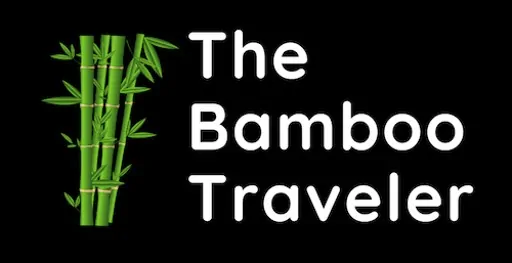
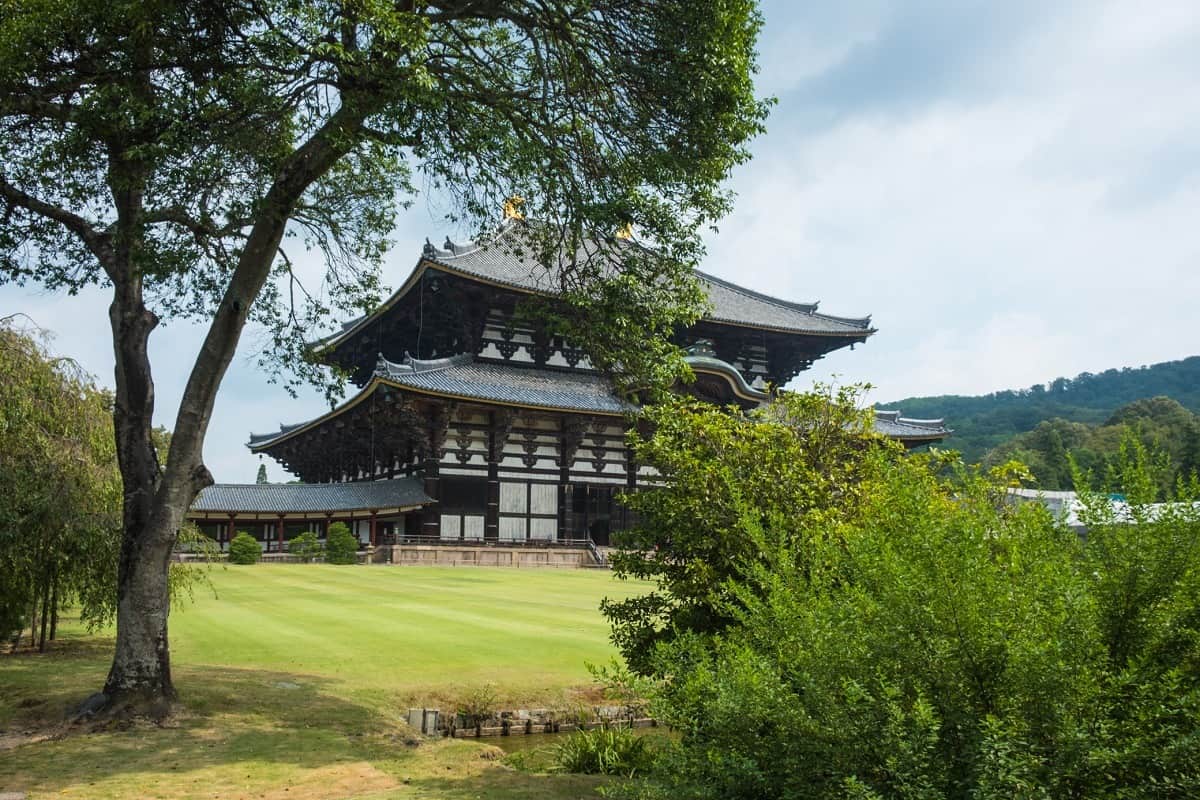


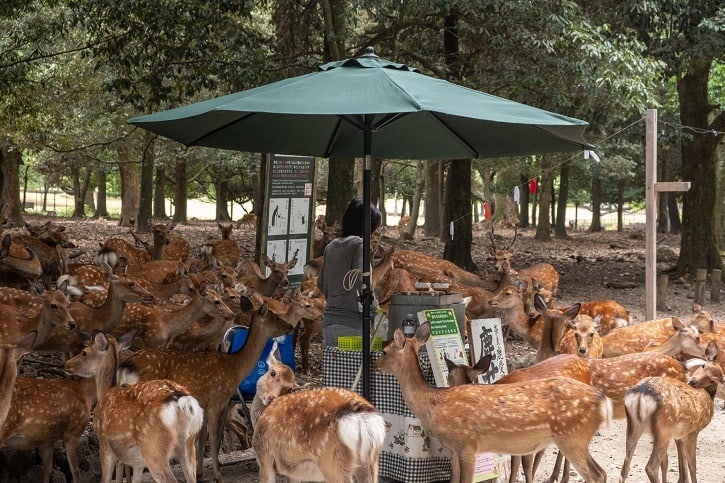









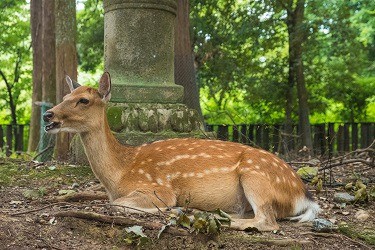






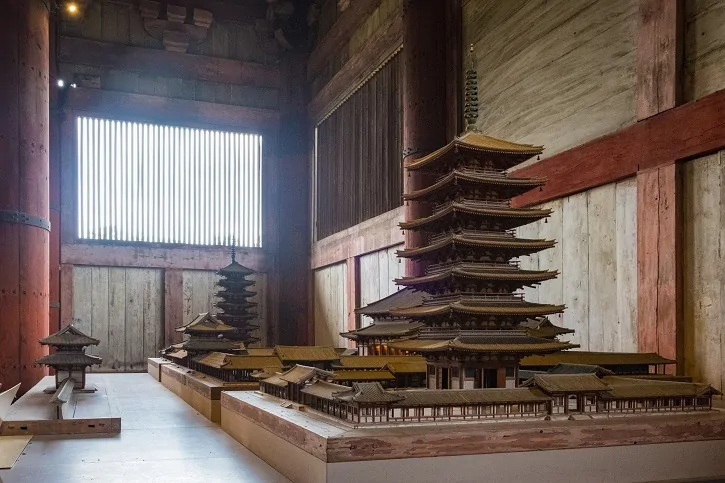












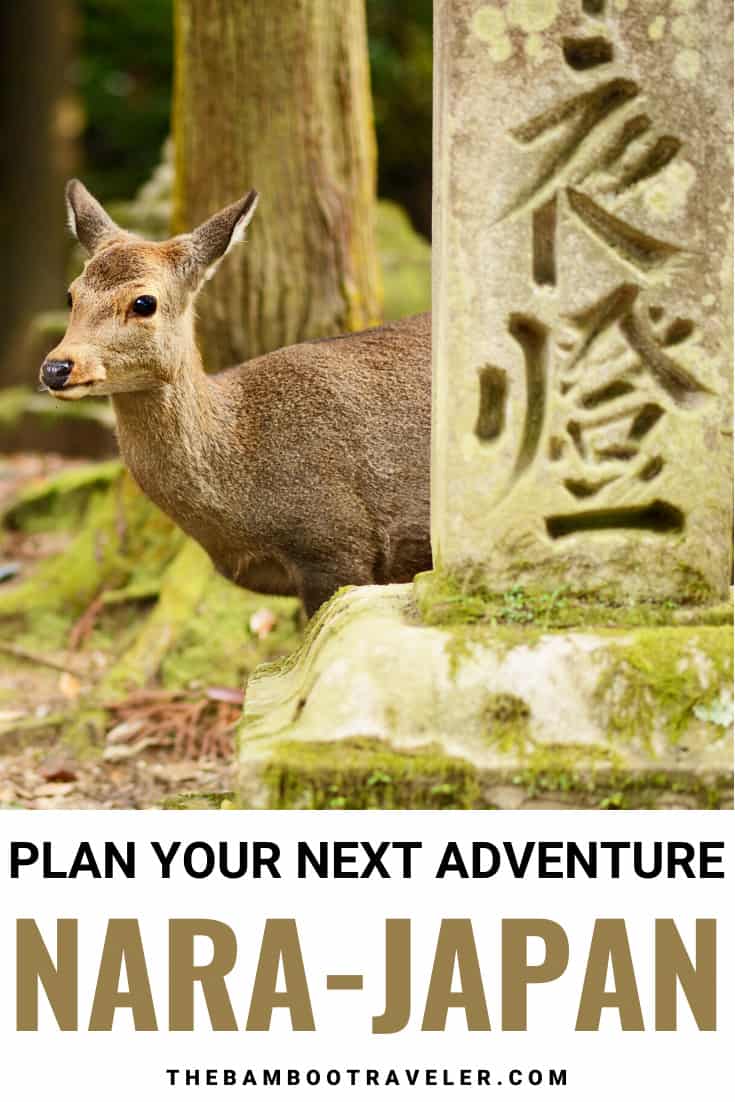




We just came back from Nara, and your guide was awesome!
Deer snacks are now ¥200. Darn inflation!
Thank you so much! I’m glad my guide helped you in planning your trip! Good to know about the increase in prices of the deer snacks.